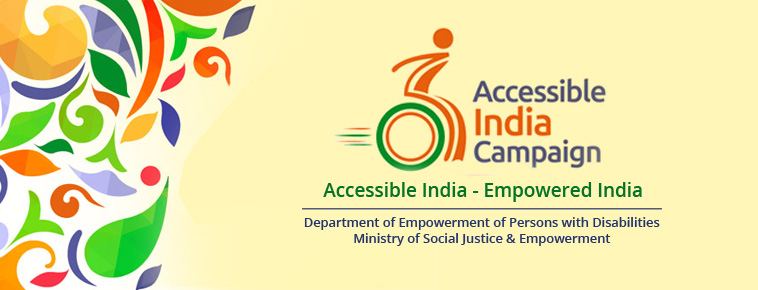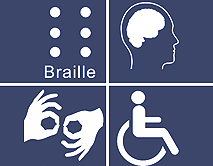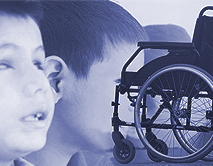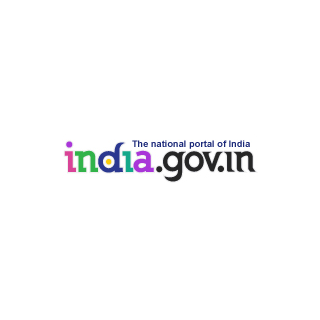
Accessible India Campaign (Sugamya Bharat Abhiyan) is a nation-wide Campaign launched by Department of Empowerment of Persons with Disabilities (DEPwD) of Ministry of Social Justice & Empowerment to provide universal accessibility to persons with disabilities.
The campaign aims at providing equal opportunity to persons with disabilities to participate in all the aspects of life and live independently. The Sugamya Bharat Abhiyan focuses on developing accessible physical environment, transportation system and Information & communication ecosystem.
The Government of India with firm commitment towards socio-economic transformation of the persons with disabilities is making efforts to create mass awareness for universal accessibility.
India is a signatory to the UN Convention on the Rights of Persons with Disabilities (UNCRPD). Article 9 of UNCRPD casts an obligation on all the signatory governments to take appropriate measures to ensure to persons with disabilities access, on an equal basis with others, to the physical environment, to transportation, to information and communications, including information and communications technologies and systems, and to other facilities and services open or provided to the public, both in urban and in rural areas.
All the States are required to follow the Persons with Disabilities (Equal Opportunities, Protection of Rights and Full Participation) Act, 1995 under sections 44, 45 and 46 categorically provides for non-discrimination in transport, non-discrimination on the road and non-discrimination in built environment respectively
Department of Empowerment of Persons with Disabilities (DEPwD) through Accessible India Campaign (Sugamya Bharat Abhiyan) aims to develop an inclusive society in which equal opportunities and access is provided for the growth and development of Persons with Disabilities.

Built Environment Accessibility
The Accessible India Campaign aims to provide an accessible physical environment to everyone. To achieve this, measures needs to be undertaken to eliminate obstacles and barriers to indoor and outdoor facilities including schools, medical facilities, and workplaces. The built environment not only covers buildings, but also steps and ramps, corridors, footpaths, curb cuts, parking, entry gate, emergency exits, toilets and obstacles that block the flow of pedestrian traffic.
Transportation System Accessibility
Transportation is a vital component for independent living. The term transportation covers a number of areas including air travel, buses, taxis, and trains. Inaccessible transportation system restricts mobility, denies freedom of movement and active participation, for much of the population who may need accessible transportation. The Accessible India Campaign focuses on providing persons with disabilities an equal right to travel and use public and private transportation infrastructure with dignity and independence.
Information and Communication Eco-System Accessibility
Access to information creates opportunities for everyone in society. Access to information refers to all information. This can range from actions such as being able to read price tags, to physically enter a hall, to participate in an event, to read a pamphlet with healthcare information, to understand a train timetable, or to view webpages. The Accessible India Campaign aims to take measures to curb all societal barriers of infrastructure, and inaccessible formats that stand in the way of obtaining and utilizing information in daily life.
Objectives of Accessible India Campaign
Enhancing the proportion of accessible government buildings
An accessible government building is one, where persons with disabilities have no barrier in entering it and using all the facilities therein.
Standards of accessibility should be as consistent as possible with international standards, such as those of the ISO, taking into account the local context. In regards to the built environment, ISO 21542:2011, Building Construction - Accessibility and Usability of the Built Environment, delineates a set of requirements and recommendations concerning construction, assembly, components and fittings.
Enhancing proportion of accessible airports
An airport is accessible, if a person with a disability has no barrier in entering it, using all the facilities, and boarding and disembarking from airplanes.
Enhancing the proportion of accessible railway stations
A railway station is accessible, if a person with a disability has no barrier in entering it, using all the facilities, and boarding and de-boarding from trains.
Enhancing the proportion of accessible Public Transport
Public Transport is accessible, if persons with disabilities get an equal opportunity to travel and use public and private transportation infrastructure independently.
The revised National Urban Transport Policy (NUTP), 2014 includes universal accessibility in all the planning and implementation interventions. Indian Roads Congress code 103:2012 Guidelines for Pedestrian Facilities provides inclusive roads and street design standards.
Enhancing proportion of accessible and usable public documents and websites that meet internationally recognized accessibility standards
The Public documents should be available in accessible formats to obtain and utilize information in daily life. Public documents refer to all documents issued by the national government as well as all sub national documents. They include all publications such as laws, regulations, reports, forms and informational brochures.
Standards of accessibility will ensure conversion of public documents published as of a specified year and all current websites meeting the relevant International Organization for Standardization (ISO) criteria that are found in ISO / IEC 40500: 2012, Information Technology – W3C Web Content Accessibility Guidelines (WCAG) 2.0.
Enhancing the pool of sign language interpreters
A sign language interpreter is one, who meets professional standards in the official sign language.
Enhancing the proportion of daily captioning and sign-language interpretation of public television news programmes
The proportion of public television news programmes that meet agreed upon standards of daily captioning and sign-language interpretation. Public television refers to programmes that are produced, funded or subsidized by the government.

Department of Empowerment of Persons with Disabilities (DEPwD) has also created an Accessible India Campaign Mobile App, along with a web portal for crowd sourcing the requests regarding inaccessible places. With the app, any person seeking to inform the Government regarding inaccessible public places (like a school, hospital, government office etc.) can click a photograph or video and upload it on the Accessible India portal. The portal will process the request for access audit, financial sanction and final retrofitting of the building to make it completely accessible. The mobile app and portal also seek engagement of big corporates and PSUs to partner in the campaign by offering their help to conduct access audit and for accessibility- conversion of the buildings/transport and websites.
Targets of Accessible India Campaign
The Sugamya Bharat Abhiyan has ambitious targets with defined timelines:
- Conducting accessibility audit of most important government buildings and converting them into fully accessible buildings
- Conducting accessibility audit of at least 50 most important government buildings and converting them into fully accessible buildings by July 2016 in the 26 cities.
- Conducting accessibility audit of at least 25 most important government buildings and converting them into fully accessible buildings by July 2016 in the 24 cities.
- Converting 50% of all the government buildings of National Capital and all the State capitals into fully accessible buildings by July 2018.
- Conducting audit of 50% of government buildings and converting them into fully accessible buildings in 10 most important cities / towns of all the States by July 2019
- Conducting accessibility audit of all the international airports, railway stations and Government owned public transport carriers and converting them into fully accessible international airports, railway stations and public transport carriers
- Conducting accessibility audit of all the international airports and converting them into fully accessible international airports by July 2016
- Conducting accessibility audit of all the domestic airports and converting them into fully accessible airports by March 2018
- Ensuring that A1, A & B categories of railway stations in the country are converted into fully accessible railway stations by July 2016
- Ensuring that 50% of railway stations in the country are converted into fully accessible railway stations by March 2018
- Ensuring that 25% of Government owned public transport carriers in the country are converted into fully accessible carriers by March 2018
- Conducting accessibility audit of 50% of all government websites and all public documents (both Central and State Governments) and converting them into fully accessible websites and documents by March 2017
- Conducting accessibility audit of 50% of all government (both Central and State Governments) websites and converting them into fully accessible websites by March 2017
- Ensuring that at least 50% of all public documents issued by the Central Government and the State Governments meet accessibility standards by March 2018
- Training and developing 200 additional sign language interpreters by March 2018
- Developing and adoption of national standards on captioning and sign-language interpretation in consultation with National media authorities by July 2016
- Ensuring that 25% of all public television programmes aired by government channels meet these standards by March 2018
Accessible India Campaign seeks cooperation of all Central Government Departments/ Ministries and State Governments for creating accessible police stations, accessible hospitals, accessible tourism, accessible digital India, etc.
Related Links






